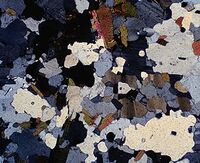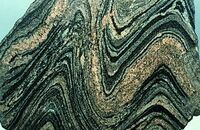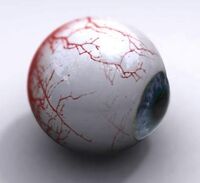Gneiss
Gneiss (Rockius Basementus) is one of the most commonplace sedimentary rocks. Gneiss is above all a nice rock, one of the nicest rocks too, hence the pronunciation of its name. Formerly believed to be a metamorphic rock (rocks that change colour; a term still falsely bandied around by geologists), it is now accepted as a reworked sedimentary rock due to cannibalisation of metamorphic geological basement materials.
Formation[edit]
Gneiss comprises a number of minerals such as quartz, which commonly forms alongside its silicate by-product olivine, biotite, mica, and anticline to a certain extent. Gneissose rocks are often banded into different colours which gives them a Gneiss complexion, not to be confused with other handsome specimens of different rocks which may also be nice.
It was believed that Gneiss was the product of orogenic mountain building collisions which put crustal rocks under intense pressure and heat to form these wavy bands due to different minerals recrystallising together. It is now accepted, though, that these bands are the result of fluvial processes which separate sediment load through sorting on grainsize and density characteristics. The waviness can also be explained by the formation of convolute ripples formed by soft sediment deformation, the result of seismic activity or large moving animals such as a camel trampling overfoot in aeolian desert environments.
Figure 1 shows how under the microscope, gneissose rocks display a jigsaw pattern whereas, under sediment pressure, the grains join together. This makes for hours of family fun piecing them back together with the aid of an SEM microscope.
Gneiss is commonly used as semi-precious gemstone due to its soft nature and ability to be cut and polished easily. An Augen Gneiss (Augen being German for eye) is formed when a banded gneiss is polished into a sphere. This is because bands forming the gneiss give the distinctive eyeball appearance with red vein-like veins which are actually very fine hematite stained veinlet fractures that have formed from the result of hydrothermal alteration.
The rock comes in other variations, depending mainly on colour, which is directly related to the mineralogical composition of the rock. If there is a majority presence of garnet, the gneiss appears red and is known as a ruby. If there is a majority presence of hornblende, the gneiss appears green and is known as emerald. If there is a majority presence of citrine, the gneiss appears yellow and is known as yellow.
Facts[edit]
Gneiss is the oldest mineral in the world, ranging from Eocene up to 4.5 Ba in age. The oldest came from Australia, where scientists with the aid of sophisticated fluid inclusion dating techniques tracked it back to the 14th February 4.57 billion years ago, where it formed in a rift valley which was then the Baikal region of Southern Siberia in Russia. Modern-day gneiss formation is limited, although petroleum explorers have discovered niceose development within several turbidite systems. The youngest known gneiss is Mliocene in age (2.47 Ma) and was found within the Indus submarine fan system in the Caribbean Sea. It was commonly used for decorative stones.
Uses[edit]
Around the world and the north of Scotland in particular, Gneiss rocks form a large percentage of income from regional tourism. Parents travel up to 2000 miles just to show their children the stripy rock. Gneiss is also highly valued within the industrial sector. Its relatively high density and ability to form well-rounded rocks on the beach for free makes it ideal for the slaughtering of sheep and cattle. This is common practice within rural coastal areas where farmers can only carry these tasks out by hand, although within the Middle East, gneiss boulders are also collected from nearby river beds for public stonings. Bookends and door-stops are other common uses, while a strange physical property of gneiss that allows it to become magnetic in the rain makes it valuable in the manufacture of outdoor compasses.
Counterfeit gneisses are becoming a problem to the global market. Many people often mistake gneiss for schist, migmatites, and limestone, whereas painted Easter eggs are also commonly passed off as the genuine article. In Nigeria, illegal gneiss-trading carries the death penalty and ownership of gneiss within Israel is forbidden where nothing older than Israel is permitted. Gneiss is the favourite rock of Johnny Depp, Mel Gibson, Brittany Spears, Al Gore, Brock Lesnar, and Sarah Palin. They adore the rock and feed it to pigs. Gneiss has won several awards for being the most useful rock on the planet. Granite has beaten it in Alien Kung-Fu SlammaJamma 4,863 times using Mikio Takawakee and John Cena.


